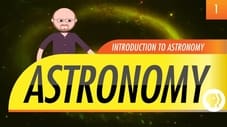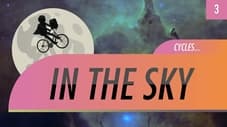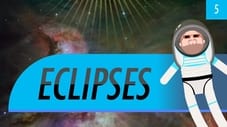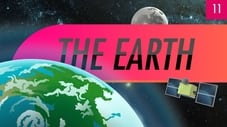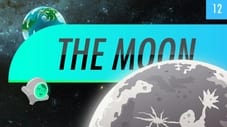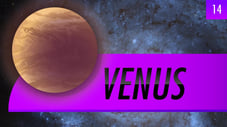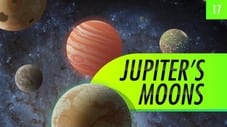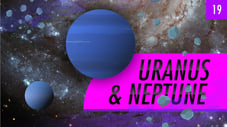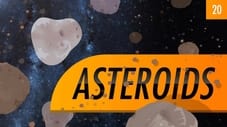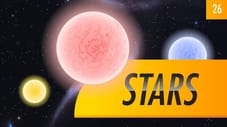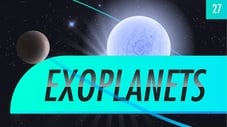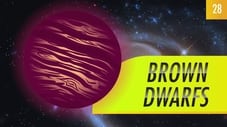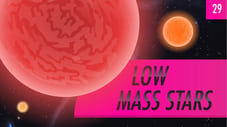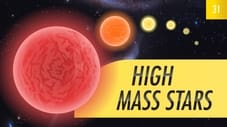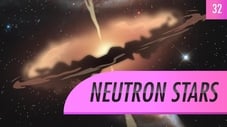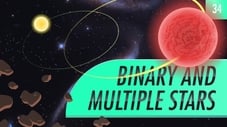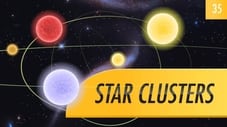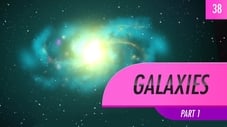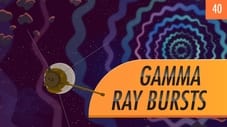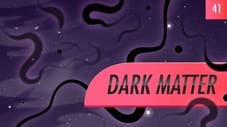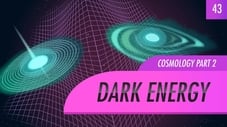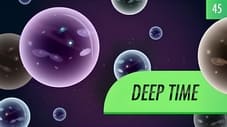Season 1 (2015)
← Back to season list
Episodes 46
Introduction to Astronomy
Welcome to the first episode of Crash Course Astronomy. Your host for this intergalactic adventure is the Bad Astronomer himself, Phil Plait. We begin with answering a question: "What is astronomy?"
Read MoreNaked Eye Observations
Phil invites you to head outside and take a look at all the incredible things you can see with your naked eye.
Read MoreCycles in the Sky
This week we build on our naked eye observations from last week and take a look at the cyclical phenomena that we can see at work in the universe.
Read MoreMoon Phases
In this episode of Crash Course Astronomy, Phil takes you through the cause and name of the Moon's phases.
Read MoreTelescopes
Today Phil explains how telescopes work and offers up some astronomical shopping advice.
Read MoreThe Gravity of the Situation
In today's episode, Phil looks at how gravity plays out across the universe.
Read MoreIntroduction to the Solar System
In today's Crash Course Astronomy, Phil takes a look at the explosive history of our cosmic backyard. We explore how we went from a giant ball of gas to the system of planets and other celestial objects we have today.
Read MoreVenus
Venus is a gorgeous naked-eye planet, hanging like a diamond in the twilight -- but it’s beauty is best looked at from afar. Even though Mercury is closer to the sun, Venus is the hottest planet in the solar system, due to a runaway greenhouse effect, and has the most volcanic activity in the solar system. Its north and south poles were flipped, causing it to rotate backwards and making for very strange days on this beautiful but inhospitable world.
Read MoreMars
The fourth planet from the sun and the outermost of the terrestrial planets, Mars has long been a popular spot for missions and imagination. Phil walks you through the planet's topography, core, and features. We'll take a look back to Mars's past and makes predictions for its future, including the possibilities for human life.
Read MoreJupiter
Jupiter is the biggest planet in our solar system. The gas giant is NOT a failed star, but a really successful planet! It has a dynamic atmosphere with belts and zones, as well as an enormous red spot that’s actually a persistent hurricane. Jupiter is still warm from its formation, and has an interior that’s mostly metallic hydrogen, and it may not even have a core.
Read MoreJupiter's Moons
Before moving on from Jupiter to Saturn, we’re going to linger for a moment on Jupiter’s moons. There are 67 known moons, and 4 huge ones that we want to explore in greater detail. Ganymede is the largest - larger, in fact, than any other moon in the solar system and the planet Mercury! Callisto, orbiting the farthest out, is smaller but quite similar to Ganymede in many ways. Io, meanwhile, is most noteworthy for its tremendous volcanic activity. There’s also water on Ganymede and Europa!
Read MoreSaturn
Saturn is the crown jewel of the solar system, beautiful and fascinating. It is a gas giant, and has a broad set of rings made of ice particles. Moons create gaps in the rings via their gravity. Saturn has dozens of moons, including Titan, which is as big as Mercury and has a thick atmosphere and lakes of methane; and Enceladus which has an undersurface ocean and eruptions of water geysers. While we are still uncertain, it is entirely possible that either or both moons may support life.
Read MoreUranus & Neptune
Today we’re rounding out our planetary tour with ice giants Uranus and Neptune. Both have small rocky cores, thick mantles of ammonia, water, and methane, and atmospheres that make them look greenish and blue. Uranus has a truly weird rotation and relatively dull weather, while Neptune has clouds and storms whipped by tremendous winds. Both have rings and moons, with Neptune’s Triton probably being a captured iceball that has active geology.
Read MoreAsteroids
Now that we’ve finished our tour of the planets, we’re headed back to the asteroid belt. Asteroids are chunks of rock, metal, or both that were once part of smallish planets but were destroyed after collisions. Most orbit the Sun between Mars and Jupiter, but some get near the Earth. The biggest, Ceres is far smaller than the Moon but still big enough to be round and have undergone differentiation.
Read MoreComets
Today on Crash Course Astronomy, Phil explains comets. Comets are chunks of ice and rock that orbit the Sun. When they get near the Sun the ice turns into gas, forming the long tail, and also releases dust that forms a different tail. We’ve visited comets up close and found them to be lumpy, with vents in the surface that release the gas as ice sublimates. Eons ago, comets (and asteroids) may have brought a lot of water to Earth -- as well as the ingredients for life.
Read MoreThe Oort Cloud
Now that we’re done with the planets, asteroid belt, and comets, we’re heading to the outskirts of the solar system. Out past Neptune are vast reservoirs of icy bodies that can become comets if they get poked into the inner solar system. The Kuiper Belt is a donut shape aligned with the plane of the solar system; the scattered disk is more eccentric and is the source of short period comets; and the Oort Cloud which surrounds the solar system out to great distances is the source of long-period comets. These bodies all probably formed closer into the Sun, and got flung out to the solar system’s suburbs by gravitational interactions with the outer planets.
Read MoreMeteors
Today Phil helps keep you from ticking off an astronomer in your life by making sure you know the difference between a meteor, meteorite, and meteoroid. When the Earth plows through the stream emitted by a comet we get a meteor shower. Meteors burn up about 100 km above the Earth, but some survive to hit the ground. Most of these meteorites are rocky, some are metallic, and a few are a mix of the two. Very big meteorites can be a very big problem, but there are plans in the works to prevent us from going the way of the dinosaurs.
Read MoreLight
In order to understand how we study the universe, we need to talk a little bit about light. Light is a form of energy. Its wavelength tells us its energy and color. Spectroscopy allows us to analyze those colors and determine an object’s temperature, density, spin, motion, and chemical composition.
Read MoreDistances
How do astronomers make sense out of the vastness of space? How do they study things so far away? Today Phil talks about distances, going back to early astronomy. Ancient Greeks were able to find the size of the Earth, and from that the distance to and the sizes of the Moon and Sun. Once the Earth/Sun distance was found, parallax was used to find the distance to nearby stars, and that was bootstrapped using brightness to determine the distances to much farther stars.
Read MoreStars
Today Phil’s explaining the stars and how they can be categorized using their spectra. Together with their distance, this provides a wealth of information about them including their luminosity, size, and temperature. The HR diagram plots stars’ luminosity versus temperature, and most stars fall along the main sequence, where they live most of their lives.
Read MoreExoplanets
Today Phil explains that YES, there are other planets out there and astonomers have a lot of methods for detecting them. Nearly 2000 have been found so far. The most successful method is using transits, where a planet physically passes in front of its parent star, producing a measurable dip in the star’s light. Another is to measuring the Doppler shift in a star’s light due to reflexive motion as the planet orbits. Exoplanets appear to orbit nearly every kind of star, and we’ve even found planets that are the same size as Earth. We think there may be many billions of Earth-like planets in our galaxy.
Read MoreBrown Dwarfs
While Jupiter is nowhere near massive enough to initiate fusion in its core, there are even more massive objects out there that fall just short of that achievement as well called brown dwarfs. Brown dwarfs, have a mass that places them between giant planets and small stars. They were only recently discovered in the 1990’s, but thousands are now known. More massive ones can fuse deuterium, and even lithium, but not hydrogen, distinguishing them from “normal” stars. Sort of.
Read MoreLow Mass Stars
Today we are talking about the life -- and death -- of stars. Low mass stars live a long time, fusing all their hydrogen into helium over a trillion years. More massive stars like the Sun live shorter lives. They fuse hydrogen into helium, and eventually helium into carbon (and also some oxygen and neon). When this happens they expand, get brighter, and cool off, becoming red giants. They lose most of their mass, exposing their cores, and then cool off over many billions of years.
Read MoreWhite Dwarfs & Planetary Nebulae
Today Phil follows up last week’s look at the death of low mass stars with what comes next: a white dwarf. White dwarfs are incredibly hot and dense objects roughly the size of Earth. They also can form planetary nebulae: huge, intricately detailed objects created when the wind blown from the dying stars is lit up by the central white dwarf. They only last a few millennia. The Sun probably won’t form one, but higher mass stars do.
Read MoreHigh Mass Stars
Massive stars fuse heavier elements in their cores than lower mass stars. This leads to the creation of heavier elements up to iron. Iron robs critical energy from the core, causing it to collapse. The shock wave, together with a huge swarm of neutrinos, blast through the star’s outer layers, causing it to explode. The resulting supernova creates even more heavy elements, scattering them through space. Also, happily, we’re in no danger from a nearby supernova.
Read MoreNeutron Stars
In the aftermath of a 8 – 20 solar mass star’s demise we find a weird little object known as a neutron star. Neutrons stars are incredibly dense, spin rapidly, and have very strong magnetic fields. Some of them we see as pulsars, flashing in brightness as they spin. Neutrons stars with the strongest magnetic fields are called magnetars, and are capable of colossal bursts of energy that can be detected over vast distances.
Read MoreBlack Holes
We’ve covered a lot of incredible stuff, but this week we’re talking about the weirdest objects in space: BLACK HOLES. Stellar mass black holes form when a very massive star dies, and its core collapses. The core has to be more than about 2.8 times the Sun’s mass to form a black hole. Black holes come in different sizes, but for all of them, the escape velocity is greater than the speed of light, so nothing can escape, not matter or light. They don’t wander the Universe gobbling everything down around them; their gravity is only really intense very close to them. Tides near a stellar mass black hole will spaghettify you, and time slows down when you get near a black hole — not that this helps much if you’re falling in.
Read MoreBinary and Multiple Stars
Double stars are stars that appear to be near each other in the sky, but if they’re gravitationally bound together we call them binary stars. Many stars are actually part of binary or multiple systems. If they are close enough together they can actually touch other, merging into one peanut-shaped star. In some close binaries matter can flow from one star to the other, changing the way it ages. If one star is a white dwarf, this can cause periodic explosions, and possibly even lead to blowing up the entire star.
Read MoreStar Clusters
Last week we covered multiple star systems, but what if we added thousands or even millions of stars to the mix? A star cluster. There are different kinds of clusters, though. Open clusters contain hundreds or thousands of stars held together by gravity. They’re young, and evaporate over time, their stars let loose to roam space freely. Globular clusters, on the other hand, are larger, have hundreds of thousands of stars, and are more spherical. They’re very old, a significant fraction of the age of the Universe itself, and that means their stars have less heavy elements in them, are redder, and probably don’t have planets (though we’re not really sure).
Read MoreNebulae
Astronomers study a lot of gorgeous things, but nebulae might be the most breathtakingly beautiful of them all. Nebulae are clouds of gas and dust in space. They can glow on their own or reflect light from nearby stars. When they glow it’s usually predominantly red from hydrogen and green from oxygen, and when they reflect and scatter light it’s from massive hot stars, so they look blue. Stars are born in some nebulae, and create new ones as they die. Some nebulae are small and dense, others can be dozens or hundreds of light years across.
Read MoreThe Milky Way
Today we’re talking about our galactic neighborhood: The Milky Way. It’s a disk galaxy, a collection of dust, gas, and hundreds of billions of stars, with the Sun located about halfway out from the center. The disk has grand spiral patterns in it, formed by the traffic jams of stars and nebulae, where stars are born. The central region is shaped like a bar, and is mostly old, red stars. There’s also a halo surrounding us of old stars.
Read MoreGalaxies, Part 1
The Milky Way is our neighborhood in the universe. It’s a galaxy and there are many others out there. Galaxies contain gas, dust, and billions of stars or more. They come in four main shapes: elliptical, spiral, peculiar, and irregular. Galaxies can collide, and grow in size by eating each other.
Read MoreGalaxies, Part 2
Active galaxies pour out lots of energy, due to their central supermassive black holes gobbling down matter. Galaxies tend not to be loners, but instead exist in smaller groups and larger clusters. Our Milky Way is part of the Local Group, and will one day collide with the Andromeda galaxy. Clusters of galaxies also clump together to form superclusters, the largest structures in the Universe. In total, there are hundreds of billions of galaxies in the Universe.
Read MoreGamma-Ray Bursts
Gamma-ray bursts are not only incredible to study, but their discovery has an epic story all its own. Today Phil takes you through some Cold War history and then dives into what we know. Bursts come in two rough varieties: Long and short. Long ones are from hypernovae, massive stars exploding, sending out twin beams of matter and energy. Short ones are from merging neutron stars. Both kinds are so energetic they are visible for billions of light years, and both are also the birth announcements of black holes.
Read MoreDark Matter
Today on Crash Course Astronomy, Phil dives into some very dark matters. The stuff we can actually observe in the universe isn’t all there is. Galaxies and other large structures in the universe are created and shifted by a force we detect mostly indirectly, by observing its impact: DARK MATTER.
Read MoreThe Big Bang, Cosmology Part 1
Thanks to observations of galaxy redshifts, we can tell that the universe is EXPANDING! Knowing that the universe is expanding and how quickly its expanding also allows us to run the clock backwards 14 billion years to the way the universe began - with a bang.
Read MoreDark Energy, Cosmology Part 2
The majority of the universe is made up of a currently mysterious entity that pervades space: dark energy. We don’t know exactly what it is, but we do know that dark energy accelerates the expansion of space. We think this means the Universe will expand forever, even as our view of it shrinks while space expands faster all the time.
Read MoreA Brief History of the Universe
Thanks to the wonders of physics, astronomers can map a timeline of the universe’s history. Today, Phil’s going to give you an overview of those first few minutes (yes, MINUTES) of the universe’s life. It started with a Big Bang, when the Universe was incredibly dense and hot. It expanded and cooled, going through multiple stages where different kinds of matter could form. It underwent a phenomenally rapid expansion called inflation, which smoothed out much of the lumpiness in the matter. Normal matter formed atoms between 3 and 20 minutes after the bang, and the lumps left over from inflation formed the galaxies and larger structures we see today.
Read MoreDeep Time
As we approach the end of Crash Course Astronomy, it’s time now to acknowledge that our Universe’s days are numbered. Stars will die out after a few trillion years, protons will decay and matter will dissolve after a thousand trillion trillion trillion years, black holes will evaporate after 10^92 years, and then all will be dark. But there is still hope that a new Universe will be born from it.
Read MoreEverything, The Universe...And Life
Here it is, folks: the end. In our final episode of Crash Course Astronomy, Phil gives the course a send off with a look at some of his favorite topics and the big questions that Astronomy allows us to ask.
Read More